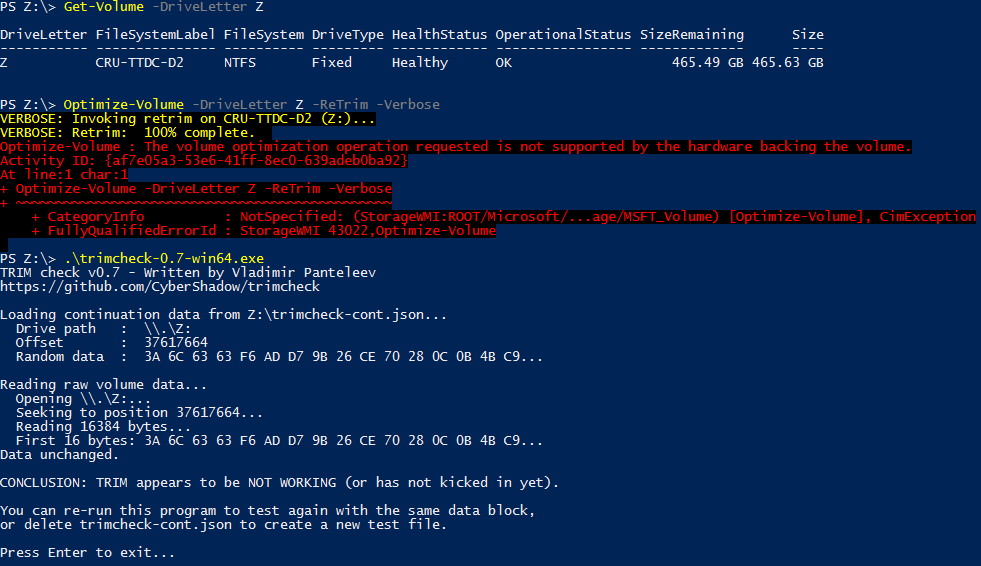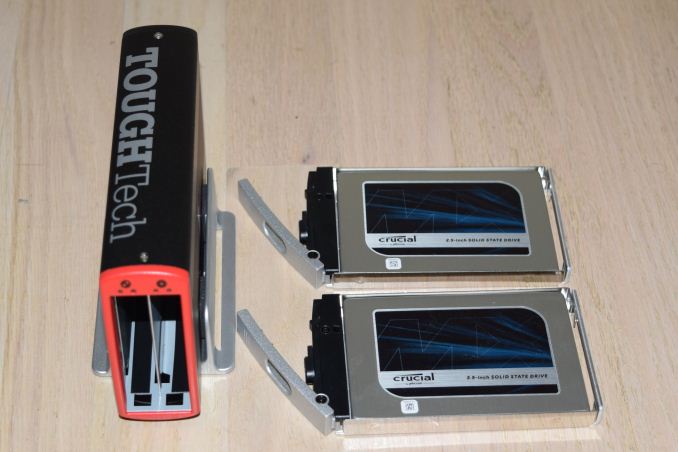CRU ToughTech Duo C Storage Enclosure (2x 2.5" to USB 3.1 Gen 2 Type-C) Review
by Ganesh T S on November 18, 2016 8:00 AM ESTMiscellaneous Aspects and Concluding Remarks
Storage bridges that support UASP fully can translate the SCSI UNMAP command to TRIM commands for SSDs connected to the downstream port. Checking for TRIM support has been a bit tricky so far. CyberShadow's trimcheck is a quick tool to get the status of TRIM support. However, it presents a couple of challenges: it sometimes returns INDETERMINATE after processing, and, in case TRIM comes back as NOT WORKING or not kicked in yet, it is not clear whether the blame lies with the OS / file system or the storage controller / bridge chip or the SSD itself. In order to get a clear idea, our TRIM check routine adopts the following strategy:
- Format the SSD in NTFS
- Load the trimcheck program into it and execute
- Use the PowerShell command Optimize-Volume -DriveLetter Z -ReTrim -Verbose (assuming that the drive connected to the storage bridge is mounted with the drive letter Z)
- Re-execute trimcheck to determine status report
Conclusions can be made based on the results from the last two steps. For the ToughTech Duo C, we first tested out TRIM support for one of the drives in a JBOD configuration.
Given that TRIM support doesn't exist even for JBOD configuration, there is no point testing out the RAID configurations. CRU indicated that they are waiting for support from ASMedia to issue a firmware update with TRIM support. So, it is conceivable that we will be able to get TRIM support in the future for the JBOD configuration, at the least.
One of the interesting aspects that deserves mention again is the bus-powered nature of the unit. There is a LED indicator to inform users of the need to use a power adapter. But, we found in our testing with multiple PCs that a green light doesn't necessarily mean that the adapter is not necessary. In certain bus-powered cases, we found that the internal volume would mount, but, hang in the course of some stressful operations. In some cases, using a shorter Type-C to Type-C cable resolved the issue. In other cases, we had to use the power adapter. The symptom and resolution varied from system to system. It also depends on the power consumption of the 2.5" drives used in the enclosure. For completely flawless operation, it is advisable to use the AC power adapter irrespective of the USB POWER LED status.
The CRU ToughTech Duo C is currently available only on CRU's product page. There are various SKUs available with pre-installed hard-drives and SSDs. The diskless enclosure is priced at $179. This is quite steep compared to the $89 for the MiniPro RAID V3 from Oyen Digital. The latter even supports 2.5" drives that are 15mm thick, compared to the 9.5mm drives supported by the ToughTech Duo C. However, the ToughTech Duo C has easily removable drive bays and a more compact profile. Based on the user manual of the MiniPro RAID V3, it appears that the ToughTech Duo C is simpler to configure and operate.
The CRU ToughTech Duo C belongs to a unique class of products enabled by the emergence of the USB 3.1 Gen 2 Type-C standard. It is a good fit for a variety of use-cases involving backups and the necessity for fast storage. Our only point of concern is the pricing compared to other similar products in the market. Based on CRU's profile, it appears that the majority of their business is selling to big companies and government agencies - $179 is a price that those entities might be willing to pay for the ToughTech Duo C. From the perspective of the average consuer, it is just a bit too high despite the industrial design deserving a premium.












25 Comments
View All Comments
Meteor2 - Sunday, November 20, 2016 - link
I believe there is a subtle difference between 3.0 and 3.1 Gen 1 -- the latter uses a more efficient encoding scheme, so real-world performance is better even though the theoretical data rate is the same.Personally though I just check new devices for Gen 2. No Gen 2, no buy. Yeah, it would be better if it had been USB 3.2 or 4, but 'Gen 2' is easy-enough to remember.
Meteor2 - Sunday, November 20, 2016 - link
I'm right in thinking that these devices are limited by the 'downstream' SATA interface, rather than the USB link, aren't I? Gen 1 can shift about 600 MBps but Gen 2 can transfer 1200. So it would need NVMe drives for the upstream link to become saturated.vladx - Thursday, November 24, 2016 - link
You forgot the encoding overhead, Gen 1 tops around 480 MBps and Gen 2 at ~1000 MBps.ironwing - Sunday, November 20, 2016 - link
Ganesh, were you provided any drop test certifications or test results for this drive? The "ToughTech" name implies that the unit is ruggedized but I don't see any mention of shock resistance in the review. Is the unit ruggedized comparable to a LaCie or Transcend external drive?AKMtnr - Tuesday, November 22, 2016 - link
RE: reviewso n Anandtech: I'm just happy to have a break from the constant onslaught of SSD's that are only slightly different than each other!I have the FW800/eSATA version of the Tough Tech Duo and being able to run dual drives without having to lug around external power has been awesome. (I do a lot of photography and videography, mostly in remote places with a backpack and not much else). I had a HDD die and had to shell out $1900, so I'm pretty into RAID1 drives now. (in addtion to online backups, calm down, I know "RAID IS NOT A BACKUP") I'm too poor for SSD's though, I put two 2TB HDD's in it.
Will definitely look into this one now that I got a touchbar MBP a couple days ago. Trying to leave the donglelife, and this brand has been rock solid in build quality and reliability.